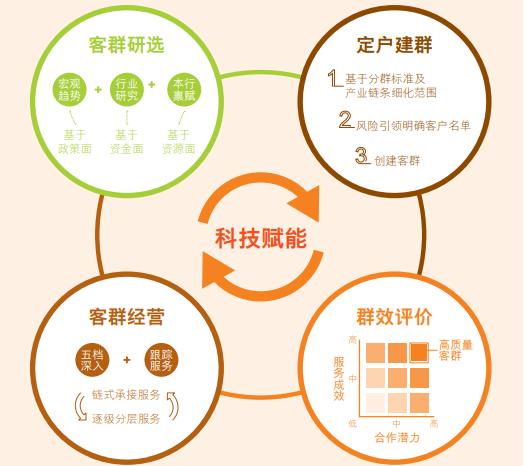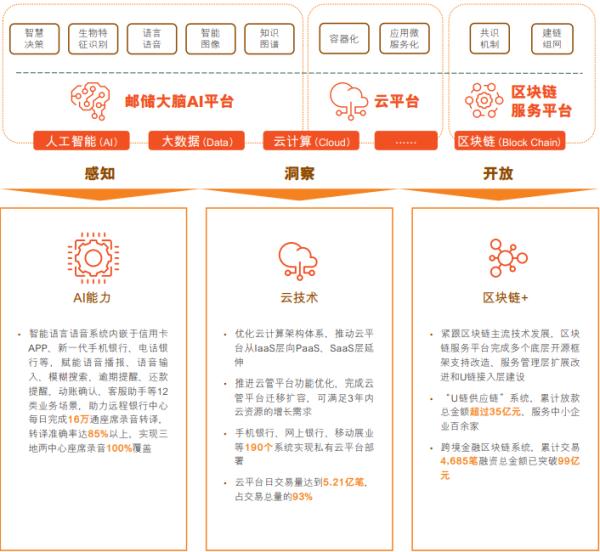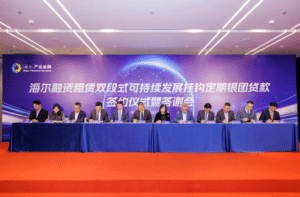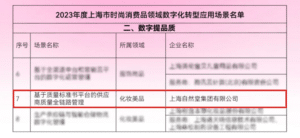13 Trillion Postal Savings Bank’s Road to Technological Advancement

[ad_1]
The digital transformation of banks has become an irreversible trend of the times in the global banking industry.in from“follow“arrive“to lead“In the process of bank digitization,Today’s Postal Savings Bankstood up“science and technologyXingxing“A new journey, a new starting pointsuperior.Postal Savings Bankfinancial technology revolution,isRedefine the bank of the future.
With mobile Internet, artificial intelligence and other technologies entering a stage of rapid development, cutting-edge technologies such as quantum communication and biotechnology have opened up the imagination space, and the fourth technological revolution has come.
At present, we are standing at the starting point of a new round of scientific and technological revolution. On the one hand, information technology is constantly making breakthroughs in the fields of cloud computing, artificial intelligence, and big data; on the other hand, technology is continuously transforming traditional industries.
Whether we like it or not, the technological revolution will fundamentally improve production efficiency in a geometric order, and then restructure the business model of banks.
Under the changing times, where should the banking industry go? As a “trend-seeking” bank with an asset scale of 13.5 trillion yuan, the Postal Savings Bank of China is setting a benchmark for the financial technology reform of the banking industry with the concept and practice of “prospering the bank with technology”.
Inspiration:The Butterfly Effect
Meteorologist Edward Lorenz once explained: “A butterfly in the Amazon rainforest in South America, occasionally flapping its wings, can cause a tornado in Texas two weeks later.”
On April 20, 1994, China officially connected to the Internet – using a 64K international dedicated line. This 64K international dedicated line opened the door to the Internet in China.
In 1996, Zhang Chaoyang, who returned from studying in the United States, founded Sohu; in 1997, Ding Lei founded NetEase; in the following years, Tencent, Sina, Alibaba, and Baidu sprung up like mushrooms.
This “virtual world” built with one computer and one network cable continues to attract early adopters.
Just as Chinese netizens were immersed in the Internet world, the technological Internet bubble on the other side of the ocean burst, and a storm broke out that swept the world. Domestic Internet pioneers represented by Sina, Sohu, and Netease are not doing well, and other small and medium-sized Internet companies are even facing survival difficulties.
There is no winter that cannot be overcome, and there is no spring that will not come. In 2003, the cold wave of the Internet receded, and Netease, Sohu, and Sina successively achieved full-year profits.
It was also in this year that Alibaba, which had been established for four years, put aside the portal thinking and launched an e-commerce platform Taobao in another way; followed by the launch of Alipay with the “guaranteed transaction model”.
At that time, because the initial product of Taobao was only a few yuan or dozens of yuan, the bank felt that the money earned from completing a transaction was not enough for the cost, so the bank rejected this “butterfly”.
In 2009, the year Taobao launched"Double 11"Shopping Festival."Double 11"On that day, Taobao created sales of 50 million yuan. Small and huge transactions in a short period of time put the bank payment system to a great test.
Since then, e-commerce platforms such as JD.com and Suning have continued to emerge, and at the same time, they launch multiple promotional activities every year to further accelerate the payment transaction volume of e-commerce platforms.
The Prophet of Spring River Plumbing Duck was coerced into thistechnological changeBanks, well aware that informatization construction and technology will become the commanding heights in future competition, began gearing up to “prepare”.
In 2009, Postal Savings Bank relied on its own IT team to complete the preparation of the “Post Financial IT Master Plan”. , With accounting processing as the core, it is a modern bank information system with high performance, high availability and high scalability.
After four years, Postal Savings Bank completed the construction of the personal business core system on October 25, 2014.
The core system of personal business has withstood the impact of the business peak, which shows from the side that PSBC chose to use the open system minicomputer cluster technology, which not only has the characteristics of scalability, high reliability and security of the mainframe, but also can fully Using multiple host resources to provide external services at the same time greatly reduces the impact of a single host failure on business and achieves the same business processing effect as a mainframe.
The picture is from Postal Savings Bank’s 2022 mid-year report
In addition, on the basis of “replacing mainframes with clusters of minicomputers”, Postal Savings Bank further promoted the technical route of “replacing clusters of minicomputers with PC server clusters”. The use of PC server cluster technology in the whole bank system has effectively reduced the dependence of the bank’s key information system on high-end minicomputers, and further verified the feasibility of the security and controllability of the basic hardware platform of the bank’s core system.
Postal Savings Bank has proved by practice that adhering to an independent and controllable development strategy and a low-cost and sustainable technical route are important means to enhance the core competitiveness of enterprises.
rise:Ten years of sharpening the sword
African economist Dambisa Moyo once said: “The best time to plant a tree was ten years ago, and the next best time is now.”
In 2014, the number of mobile Internet users surpassed that of PC Internet for the first time. Smartphones are gradually penetrating into all areas of people’s lives and work. Rich and colorful mobile Internet applications such as WeChat, Weibo, mobile games, and mobile payments have become “necessities” for life in the information age.
Mobile Internet is a revolution in thinking and market. In the era of mobile Internet, advertising is no longer limited to display, and is no longer just a brand promotion, but is more directly related to purchase; banking business is no longer limited to outlets, but to satisfy customers by setting up scenes and building ecology financial service needs.
In order to seize the dividends of the mobile Internet era, Postal Savings Bank started and completed the preparation of the Bank’s “13th Five-Year Plan” IT plan in 2014. The “13th Five-Year” IT plan aims to meet the requirements of its own development strategy, and in accordance with the requirements of “10-year vision and five-year plan”, strategically guide PSBC’s future informatization work.
Compared with the “system integration and data concentration” emphasized in the 2009 plan, the “13th Five-Year Plan” IT plan is based on the concept of “smart innovation, interconnection and sharing”, and builds informatization capabilities into the core competitiveness of Postal Savings Bank.
Since the implementation of the “Thirteenth Five-Year Plan” IT plan, the information technology of Postal Savings Bank has ushered in a leapfrog development. It has built 16 major platforms such as credit business and CRM, two buses (enterprise service bus, enterprise data bus), and 234 information systems, which have significantly improved Seven major business capabilities, including customer service, channel collaboration, product innovation, process optimization, business decision-making, marketing performance, and comprehensive risk, have been established.
With the rise of third-party payment and online business, and the rapid development of PSBC’s personal business, the average daily transaction volume of the old core system has grown rapidly by 20-30% every year, and the peak transaction volume is gradually approaching the upper limit of the design capacity. If the problem of system expansion is not resolved, this will become a constraint to continue to support the rapid development of Postal Savings Bank’s personal business.
Those who are good at chess plan things, and those who are good at planning will go far. In order to reverse this situation, Postal Savings Bank launched the construction of a new generation of personal business core system in March 2019.
The core system is the brain and heart of a bank, and it is also an important embodiment of a bank’s technological strength. In order to build a new generation of core system, Postal Savings Bank has adopted a two-pronged strategy of “talent + capital”.
The first is to increase investment. In 2019, Postal Savings Bank proposed that in order to achieve the goal of technology-driven development, about 3% of its operating income will be invested in the field of information technology every year. In 2018, that figure was 2.75%. In 2019, Postal Savings Bank invested more than 8 billion yuan in information technology, a year-on-year increase of more than 10%, accounting for 2.96% of revenue. In 2020, PSBC will invest more than 9 billion yuan in information technology, a year-on-year increase of 10.35%, accounting for 3.15% of revenue.In 2021, PSBC will invest more than 10 billion yuan in information technology, accounting for 3.15%.
The second is to strengthen team building. In order to “recruit, retain and make good use of IT talents”, Postal Savings Bank has stepped up the introduction of talents in the technology line. In 2019 and 2020, the head office’s technology team has doubled for two consecutive years,As of the end of December 2022, it will reach more than 4,300 people, and the whole bank will exceed 6,300 people. In addition to the outsourcing team, the total number will exceed 15,000.
At the same time, Postal Savings Bank also optimized and perfected the rank system of scientific and technological positions, formed seven professional sequences including information technology structure, demand, research and development, technical testing, operation and maintenance, data analysis, and technological risk, and opened up the promotion channel for IT professional talents; formulated The management measures for leading scientific and technological talents have been formulated, and leading scientific and technological talents in ten fields including technical architecture, data analysis, artificial intelligence, blockchain, and cloud computing have been selected and hired, and a three-level talent echelon of “youth, backbone, and leader” has been established.In terms of performance appraisal, Postal Savings Bank implements differentiated performance-based salary distribution for technology lines to fully mobilize the enthusiasm and creativity of scientific and technological personnel.
The last is to optimize the institutional mechanism. With the rapid increase of capital investment and scientific and technological personnel, the information technology system and mechanism of Postal Savings Bank has been continuously adjusted and optimized, forming an information technology management department, a financial technology innovation department, a data management department, a software research and development center, and a data center. “Centre” IT organizational structure, making scientific and technological management more professional and efficient, greatly shortening the construction cycle of information technology projects, and speeding up innovation significantly.
Butterfly change:technology empowerment
Innovative butterfly changes lead technology empowerment.
From the launch in March 2019 to the full-scale production and launch of the new generation of personal business core system in 2022, it marks the “butterfly change” upgrade of PSBC’s core technological capabilities.
It is reported that Postal Savings Bank’s new-generation personal business core system is the first among large banks to adopt enterprise-level business modeling and distributed micro-service architecture at the same time, and run all personal business 24/7 on the safe and controllable distributed architecture of the full technology stack.
In addition, Niu Xinzhuang, chief information officer of Postal Savings Bank, said that Postal Savings BankIt has also independently developed a distributed technology platform and operation and maintenance platform based on open source databases and general-purpose servers, which have been successively applied to the construction of multiple “new generation” systems such as the new generation of corporate business core systems and the new generation of credit card core systems, becoming a bank-level An important capability carrier for the implementation of the technical architecture.
This move has a demonstration effect in fully implementing the national network security strategy, improving the ability to independently control key core technologies, and promoting the transformation of the core systems of large and medium-sized banks.
In addition to tackling key core technologies and achieving high-level technological self-reliance, the launch of the new-generation personal business core system has brought six innovations and four values to Postal Savings Bank.The six major innovation points are process reengineering, simplifying complexity; industry technology integration, agile innovation; consolidating platform, leading innovation; intelligent operation and maintenance, panoramic control; top-down, safe and controllable; The four types of value are: greatly improved performance to support business development; flexible product assembly and quick response to the market; improved customer experience and improved handling efficiency; unified data standards to consolidate risk prevention and control.

Picture from Postal Savings Bank 2022-year mid-year report
Among the six major innovations, “simplification” adopts enterprise-level business modeling methods to restructure business products and reshape business processes; “agile innovation” accelerates the response to market and customer personalized, differentiated and customized products and services speed; the “consolidated platform” forms an enterprise-level distributed technology R&D and operation capability that is continuously scalable and self-controllable; Driven operation and maintenance capabilities; “safe and controllable” through the organic combination of domestic hardware and software, open source and custom development, to build a financial core-level full-stack self-controllable capability; “online migration” to achieve new and old core systems without stopping Completed the migration of more than 650 million customers, and created a new model of switching and launching the core system.
In terms of “significantly improved performance” among the four values, the counter transaction that used to take 155 milliseconds now only takes 76 milliseconds, a time-consuming reduction of 51%. In terms of flexible product assembly, since its launch in April, it has issued more than 90 large-denomination certificates of deposit; 19 types of special debit cards of branches and key debit card products of the head office, including Meituan Rider Card, New Citizen U+ Card and Rural Revitalization Card, etc. Debit card products. In terms of improving handling efficiency, the number of counter transactions has been optimized from 465 to 336, and the counter transaction entrance has been integrated from 3 to 1. In terms of risk prevention and control, the bank established a unified customer fraud information identification and anti-money laundering/anti-fraud list maintenance mechanism, and embedded anti-fraud and anti-money laundering list verification into the transaction process.
The data shows that this new-generation personal business core system, which took 3 years to build, has been running smoothly since it was put into production, with excellent performance in various indicators, providing a peak TPS of 67,000 transactions per second for PSBC’s 650 million individual customers and nearly 40,000 outlets transaction processing capacity; the online transaction processing time of the whole day is only 65 milliseconds, which is 30% lower than that of the original system; the end-of-day processing time is reduced from 273 minutes to 197 minutes, a reduction of 28%; 25 minutes, 82% reduction.
Various performances can meet the needs of PSBC’s current 650 million customers and 67,000 transactions per second, and can also meet the needs of PSBC’s rapid business development.
The new-generation personal business core system has opened a new chapter in the development of PSBC’s financial technology, injected new momentum into the promotion of PSBC’s digital transformation, and created a new engine for the construction of a first-class large-scale retail bank.
lead:Platform “Newborn”
The iteration and transformation of technology has changed the business model of banks, replenished energy for business development, and brought “new life” to the financial form.
In 2022, the central bank issued the “Fintech Development Plan (2022-2025)”, which put forward eight key tasks, and clarified that by 2025, the overall level and core competitiveness of financial technology will achieve a leapfrog improvement.
The “14th Five-Year Plan” period is the first five years for my country to embark on a new journey to build a modern socialist country in an all-round way and march towards the second centenary goal. Data has become a new factor of production, digital technology has become a new development engine, and the wave of digital economy has become unstoppable.
Only by taking precautions can we be prepared.In March 2021,Postal Savings BankStarted the “14th Five-Year” IT planning work, from an enterprise-level perspective on business architecture, application architecture, technical architecture, data architecture,financial technologyCarry out a new layout with IT governance, and put forward the “SPEED” (SPEED) informatization strategy.
What is “SPEED” informatization strategy? It is understood that S (Smart) stands for wisdom, that is, relying on the “postal storage brain” to achieve efficient and intelligent decision-making; P (Platform) stands for platform, which realizes agile technology empowerment through platform construction; the first E (Experience) stands for experience, bringing the ultimate integrated experience to users; the second E (Ecosystem) stands for ecology, creating a symbiotic and win-win financial ecosystem; D (Digitalization) stands for digitalization, driving the transformation of the production and operation methods of the whole bank.
The proposal of the “SPEED” informatization strategy has started a new journey of PSBC’s financial technology.
Recently, Liu Jianjun, President of Postal Savings Bank of China, said in a speech at the press conference themed “Running out of the ‘acceleration’ of digital finance” that Postal Savings Bank of ChinaThe development of digital finance can be compared to a forerunner running at an accelerated pace. Strategic deployment, technology leadership, and data drive are the three core “organs” that provide power:Strategy “enters the brain” to direct the pace of development; technology “strengthens the heart” to lead service innovation; data “blood production” releases financial vitality.
Liu Jianjun said that the “strengthening heart” of science and technology is to take the “14th Five-Year Plan” IT plan as the guide, deeply promote the implementation of the “SPEED” technology strategy of wisdom, platform, experience, ecology and digitalization, and comprehensively promote the construction of a digital ecological bank.
In recent years, with the “14th Five-Year” IT plan as the guideline, Postal Savings Bank has made great efforts to continuously build a financial technology innovation pattern of “platform + capability + application”.
“PSBC Brain” and “PSBC U-Chain” are two financial technology innovation platforms created by PSBC based on new technologies such as artificial intelligence, blockchain, cloud computing, and big data.

The picture is from Postal Savings Bank’s 2022 mid-year report
As an important plan of Postal Savings Bank in the field of artificial intelligence, “PSBC Brain” is the core achievement of Postal Savings Bank’s foundation of digital intelligence.
It is reported that the “postal storage brain” constructs two areas of perception and decision-making, three platforms and six capability groups, and multi-dimensional application scenarios such as intelligent marketing, intelligent risk control, intelligent operation, and intelligent management, forming a complete set of intelligent capabilities support system.
Xu Chaohui, Chief Engineer of Postal Savings Bank, said that the current “postal savings brain” has achieved the improvement from perceptual intelligence to cognitive intelligence, and the four AI application directions of “seeing, recognizing, talking, and debating” continue to strengthen PSBC’s understanding and understanding of customers. Cognition helps optimize service forms and models, thereby improving financial service experience.
Specifically, the first is to understand, the intelligent image capability supports 15 types of general and 40 specific bills, and supports an average of nearly 420,000 image recognitions per day; the second is to recognize clearly, support multilingual, multi-channel voice services, and intelligent customer service services The replacement rate reached 78%, and the recognition accuracy rate exceeded 96%. Thirdly, the smart outbound service that supports natural voice interaction covers scenarios such as consumer credit and marketing, reaching more than 30 million customers. Multi-engine, multi-strategy biometric identification, providing more than 2 million face and voiceprint comparison and life verification services per day for more than 200 business scenarios.

The picture is from Postal Savings Bank’s 2022 mid-year report
In addition, on February 16, the Postal Savings Bank of China announced the access to Baidu’s “Wen Xin Yi Yan”, which is the first time that Baidu’s “Wen Xin Yi Yan” has been implemented in a large state-owned commercial bank. The combination of “PSBC Brain” and “Wen Xin Yi Yan” will further improve PSBC’s capabilities in areas such as generative artificial intelligence (AI), open dialogue, and cross-modal semantic understanding, and continuously improve the application of intelligent innovation efficiency.
In addition to the “PSBC Brain”, the “PSBC U-Chain” is another blockbuster product of PSBC’s financial technology innovation platform.
“PSBC U-Chain” is a blockchain application platform independently developed by Postal Savings Bank of China. It provides enterprises with convenient, easy-to-use, high-performance, secure, stable, and easy-to-expand blockchain services, and is committed to building a financial infrastructure that links trust. Based on this platform, a variety of blockchain-specific products represented by supply chain finance, government affairs finance, cross-border finance, capital supervision, etc. have been incubated.
Among them, supply chain finance has supported more than 300 small and micro enterprises, achieving a single monthly financing of more than 3 billion yuan for three consecutive months, and the amount of online lending increased by 118% year-on-year.
Looking back on the past, we have forged ahead for decades. Postal Savings Bank adheres to the concept of “prospering the bank with technology”, empowers business with technology, continues to export high-quality financial innovation products and services, continuously expands the breadth and depth of financial services, and makes new contributions to the real economy.
[ad_2]
Source link







